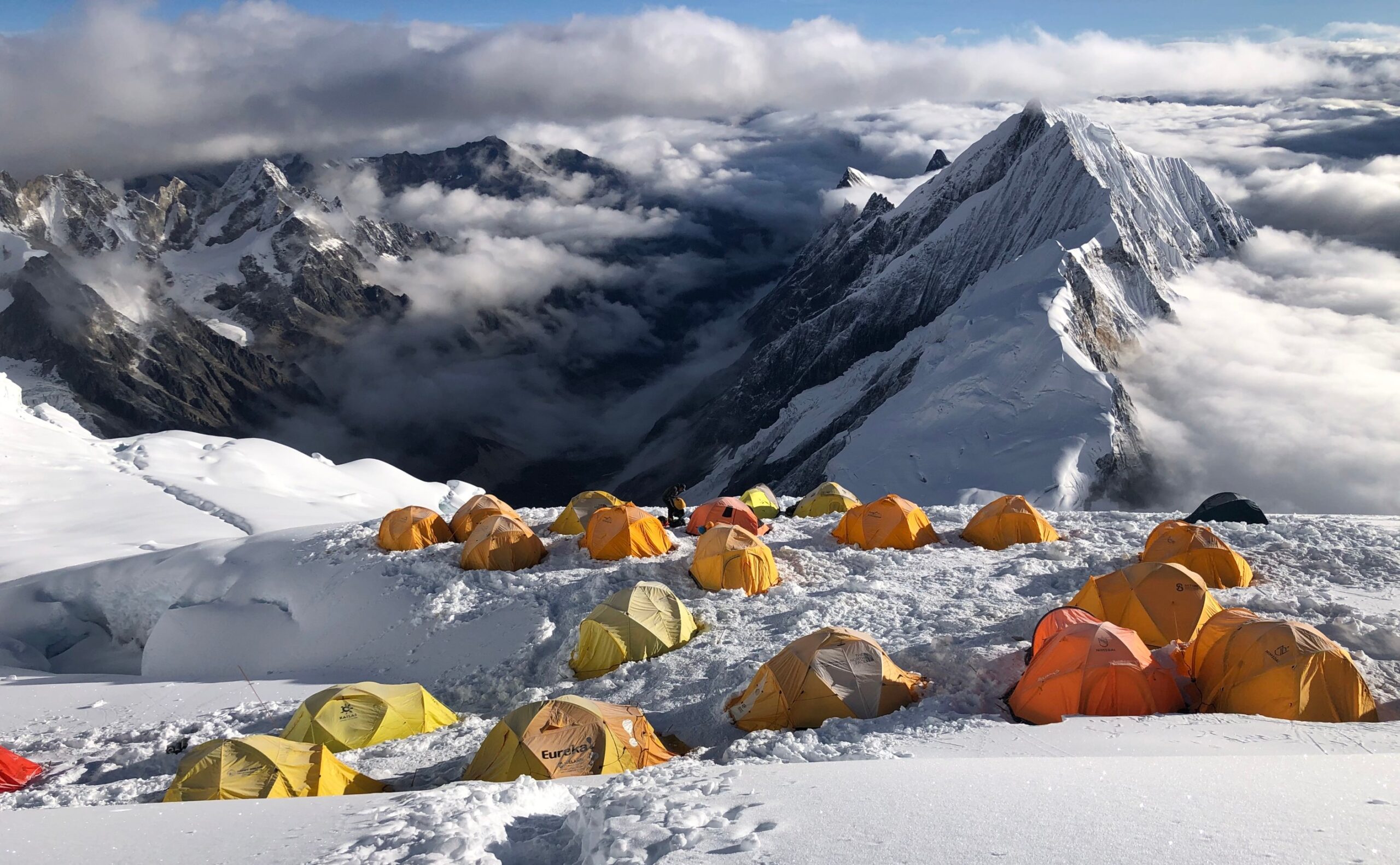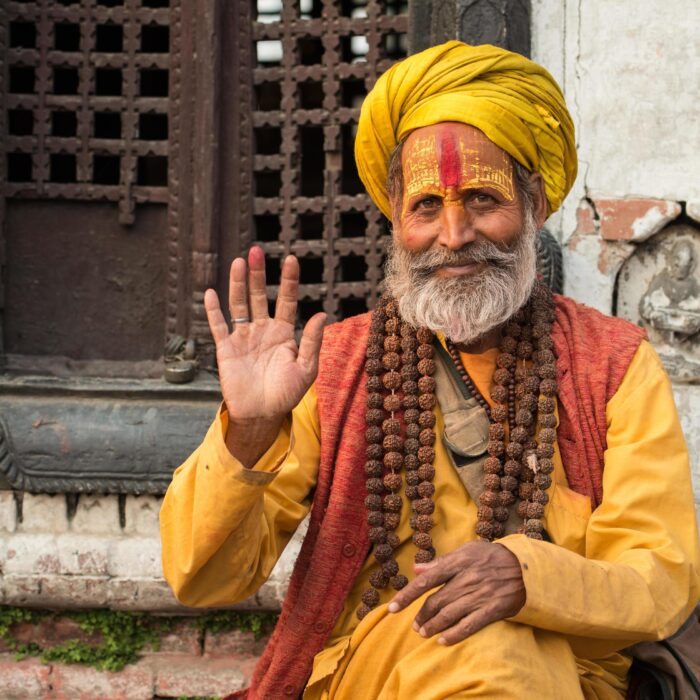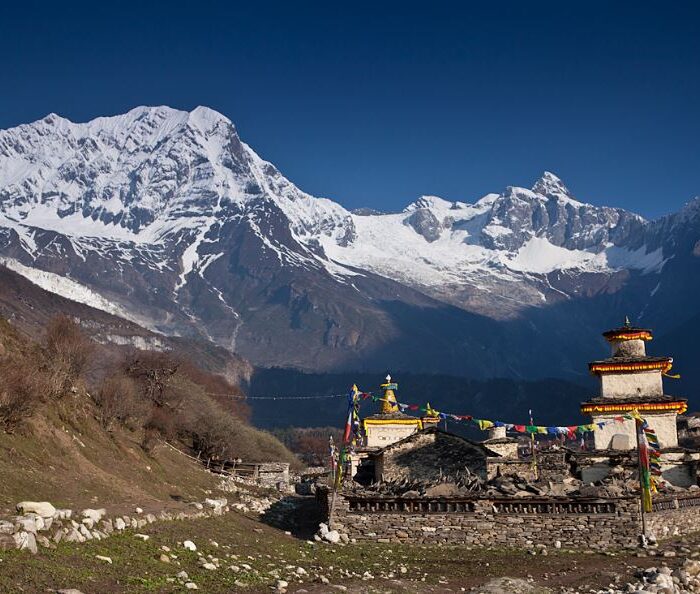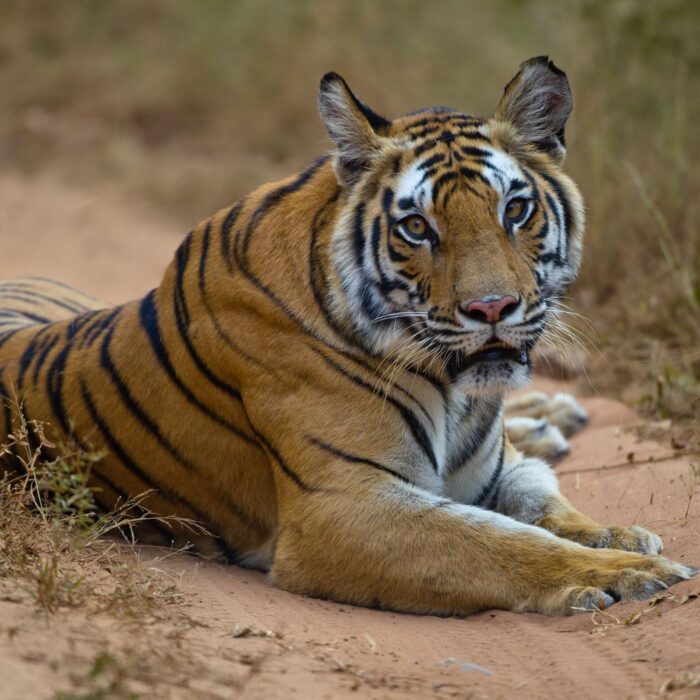Introduction to Mera Peak Climbing
Take on a 13-day climbing trip to get on top of Mera Peak. It is a grand peak at 6,476 meters (21,247 ft) above sea level. This climb will lead you through less traveled paths in the Khumbu region. It is where you’ll see great views and also visit Sherpa villages.
The Magnificent Mera Peak
Mera Peak features three summits. Mera North, Mera Central, and Mera South. Each peak offers fine views of the Himalayan giants such as Everest, Lhotse, Kangchenjunga, Makalu, and Cho Oyu. During the trek, you’ll also enjoy the vistas of Ama Dablam, Baurntse, Thamserku, and Island Peak.
Why Choose Us for Your Mera Peak Climb?
Our expert guides are ready to handle any mountain emergency. They also make sure it is a safe and successful climb. We vow a comfortable and safe climb to the top with careful attention to safety details and full climber preparation.
Mera Peak Challenge & Prep
Even though Mera Peak has a general climbing route, it requires physical and mental alert. Fitness training, getting used to heights, and also having the right gear are key to handling rough areas and heights. We would like you to check the climbing equipment list that is a must while going on the Mera Peak climb.
Altitude Sickness and Safety Measures
Being sick while on a height can threaten the hikers. However, our planned Mera peak climbing route includes plenty of rest days and gradual height gain to reduce risks. Finding out the symptoms early and following safety protocols are key to a safe climb. Similarly, you can check our AMC (Acute Mountain Sickness) which can be a good guide for you about getting ill on high heights in Nepal.
Training for Success
Preparation is vital for getting top of Mera Peak. Climbers get ready for the climb by mixing trek experience with dedicated training lasting 4 to 6 weeks. This training focuses on stamina, strength, and getting used to heights. Also, for extra information please check our trek equipment list. This list will be a guide for you if you plan to trek in Nepal.
Last Minute Booking Essentials
For FIT guests, our last minute booking option offers a fitted solution. To secure a place to stay during the trek or climb and permits quickly, we will need full payment and necessary personal details.
Optimal Climbing Seasons
Spring (March to early May) and autumn (October to November) provide ideal weather conditions for Mera Peak climbing. With stable weather and plans, they can increase their chances of peak success.
Accommodation and Meals
We vow a peaceful night’s rest and healthy meals cooked by skilled chefs to fuel up your climb. This includes a comfortable place to stay in Kathmandu’s hotels and cozy lodges along the climb route.
Essential Travel Insurance
Every climber must have travel insurance that covers medical expenses, emergency flights, and trip protection. This insurance is a must to protect against unexpected situations which may occur during the climb.
Climbing Tips for a Seamless Journey
We provide practical tips to ensure an open and fine climbing experience. It will include advice on foot wear, power options, internet link, ATM availability, and tipping grace.
Beyond Mera Peak Climbing
Are you looking for other options other than the Mera peak climbing? Explore other treks such as
Please check our trek equipment list. This list will be a guide for you if you plan to trek in Nepal. Similarly, you can check our AMC (Acute Mountain Sickness) which can be a good guide for you to learn more about getting ill on high heights in Nepal. Also, if you want to do a Peak climb in Nepal then please check the climbing equipment list that is a must while going on the Peak climb. Likewise, we suggest you check the updated TIMS card rule as there have been some new changes in Nepal.
How to Get a Nepal Visa?
You can get Nepal visas upon arrival at Tribhuvan International Airport. To make the process faster and avoid long lines, fill out the Online Nepal Visa form a week before you arrive. Bringing a printed copy with the proof number helps you get through Immigration faster. Make sure you have enough cash for the visa fee when you arrive, as the cost depends on how long you’re staying and how often you’re entering. Also, we suggest you check our tourist visa in Nepal as there have been some major changes.
Booking is Open for 2024 / 2025
Are you planning to do a trek or tour in 2024? If so, then in our Best Deals part, you can find the ideal information on the best price for the trek cost. Furthermore, book plans as soon as possible.
Contact us or Send a message or call us at
WhatsApp / Viber / Mobile: + 977 – 9851 022814, + 977 – 9841 451681
We are available 24/7
For further information, Contact us.
Itinerary
Day 1: Fly to Lukla and trek to Chutanga (3,100m/10,168ft) – 35 minutes flight and 2: 5 hours trek
We start with a morning flight to Lukla. Ideally, we’ll fly directly from Kathmandu, but if not, we’ll drive to Ramechaap from Kathmandu at 1:00 AM and fly to Lukla from there. This has all happening for the last couple of years due to air traffic. We certainly brief you before your trek departure whether you fly directly or drive to Ramechaap.
Once in Lukla, you meet our crew, arrange our luggage, and begin our trek to Chatunga. The path ascends through forests and fields, leading us to Chatunga, a quaint village nestled among cliffs and mountains, with just a few stone houses. You spend the night in a local teahouse in Chatunga.
Overnight at Lodge.
Day 2: Trek to Thuli Kharka (4,300m/14,104ft) via Zatrwa La (4,600m/15,092ft) – 5 to 6 hours trek
Our trek progresses from Chatunga to Thuli Kharka, crossing the challenging Zatra La Pass. En route, you navigate rhododendron forests and yak pastures, ascending to Zatrwa La Pass for stunning valley views. The final stretch leads you to Thuli Kharka, a serene meadow with a few teahouses, where you spend a night.
Overnight at Lodge.
Day 3: Trek to Kothe (3,691m/12,107ft) – 6 to 7 hours trek
Descending to Kothe, our trail offers spectacular views of the Hinku Valley, Kusum Kanguru, Peak 43, and Mera Peak’s south face. You pass through pine and rhododendron forests, which are especially stunning in spring when in full bloom. Upon arriving in Hinku Valley’s Kothe.
Overnight at a local teahouse.
Day 4: Trek to Thaknak (4,358m/14,295ft) – 3 to 4 hours trek
Continuing to the Upper Hinku Valley, you ascend above the tree-lined to a region of yak-grazing meadows. En route, we pause at Gondishung for tea and refreshments, enjoying panoramic views of Mera Peak, Charpati Himal, Kusum Kanguru, and Thamserku. You also visit the 200-year-old Lungsumgba Gompa, where your crews offer prayers for a successful climb. Your day concludes in Thaknak, where you enjoy a close-up view of Charpati Himal from our teahouse.
Overnight at a Thaknak teahouse.
Day 5: Trek to Khare (5,045m/16,548ft) – 3 to 4 hours trek
Your trek to Khare involves a challenging yet brief hike, with significant altitude gain. You navigate the Dig Glacier, pass the Charpati Tal glacial lake, and descend to Dig Kharka, offering splendid views of Kyeshar Glacier, Mera Peak, and Charpati Himal. The route continues over the Hinku Nup and Shar glaciers, leading us to Khare, also known as Mera Peak Base Camp. This area features a few teahouses and climbing gear shops. Once settled in a lodge, you can discuss, check, and manage all your climbing equipment with your climbing guide for your safe and convenient climbing.
Overnight stay at a Khare teahouse.
Day 6: Trek to Khare (5,045m/16,548ft) – 3 to 4 hours trek
Today, we embark on a challenging trek to Khare, gaining altitude steadily. Our route involves ascending the Dig Glacier, skirting Charpati Tal, and descending to Dig Kharka, offering stunning views of Kyeshar Glacier, Mera Peak, and Charpati Himal. We navigate the Hinku Nup and Shar glaciers, arriving at Khare, or Mera Peak Base Camp. This area, nestled at Mera Peak’s base, features a few teahouses and climbing gear shops. After settling into a lodge, we’re greeted by the spectacular north face of Mera Peak.
Overnight at Lodge.
Day 7: Rest day at Khare – Acclimatization Day and pre-climb training, recheck your equipment
Before your climb, an acclimatization day is essential for pre-climb training led by our guides. This includes practicing climbing techniques, using harnesses and other equipment on a rocky slope, and learning essential skills like knot-making, belaying, and rappelling. Especially beneficial for first-time Himalayan climbers, this session offers valuable tips and insights for a safe ascent.
There’s also a final check of gear and equipment, with an opportunity to rent any needed items. Note that climbing boots size 12 or larger are not available in Nepal, so bring them from home if required. Please reconfirm with your climbing guide and base camp crews provided by Alliance Treks all your equipment and personal gear what to take to base and what not to take to avoid all unforeseen circumstances during your climbing.
Day 8: Trek from Khare to Mera High Camp (5,780m/18,958ft) – 5 to 6 hours trek
Our trek to Mera La presents a steep, rocky path, offering views of Mera Peak’s three summits – Mera South, North, and Central, with Mera Central as our target. The ascent up the Mera Glacier to the high camp is gradual and not technically challenging, but the high altitude and cold can be tested.
At Mera High Camp, the Alliance Treks crew provides hot drinks and soup. From here, we can see five of the world’s 14 eight-thousands, including Everest, Kanchenjunga, Lhotse, Cho Oyu, and Makalu, along with impressive views of Chamlang, Baruntse, and Gaurishanker.
You camp in individual tents tonight, preparing for a long day ahead.
Day 9: Summit Mera Peak (6,461m/21,193ft) and trek to Khare (5,045m/16,548ft) – 11 to 12 hours trek/climbing
We begin our ascent at 2 AM, using headlamps and a rope for safety. Crossing the Mera Glacier, we face a gradual climb. The cold and thin air slows us down, with the last 40-50 meters being particularly challenging. Using fixed ropes and jumars, we tackle the steep incline to Mera Peak’s summit.
Reaching the summit around 9-10 AM, we enjoy brief moments with views of Everest, Makalu, Kanchenjunga, Lhotse, and Cho Oyu, and capture these memories. After a short stay of 5-10 minutes, we descend to High Camp, where a warm welcome with hot drinks awaits us. Following a rest and lunch, we make a quick descent to Khare, celebrating our achievement in the evening.
Day 10: Contingency Day for Mera Peak Summit
This day is set aside as a contingency for the summit attempt in case of bad weather or health issues on Day 9. It’s also a buffer for emergencies like flight delays or unexpected events disrupting our schedule. If all goes as planned, we can use this day for a leisurely exploration along the trail or sightseeing in Kathmandu.
Day 11: Trek from Khare to Kothe to Thuli Kharka (4,300m/14,104ft) – 8 to 9 hours trek
We retrace our steps to Kothe, with the rocky cliffs hiding the mountain views. Our journey includes an ascent west of the Hinku Valley amidst rhododendron trees, following an undulating trail. We reach Thuli Kharka, a summer camp used by local yak herders, after a final hike up a path.
Overnight at Lodge.
Day 12: Trek to Lukla (2,840m/9,316ft) via Zatrwa La Pass (4,600m/15,088ft) – 5 to 6 hours trek
Departing from Thuli Kharka, we cross the Zatrwa La pass at 4,600 meters, reaching it in about 2 hours. The pass offers incredible views, including parts of our crossed trail, the Hinku Valley, and peaks like Numbur Himal, Kongde, Dudh Kunda, and Khumbila. We then descend to Lukla.
In Lukla, we enjoy the comforts of a hot shower and a satisfying meal. The evening is marked by a celebration of our journey’s success, joined by our local crew for a memorable final night in the mountains.
Day 13: Fly from Lukla to Kathmandu (1,400m/4,593ft) – 35 minutes flight
Upon flying back to Kathmandu, we’ll head to our hotel for some rest. The remainder of the day is yours to either relax at the hotel or explore the city. A stroll through Thamel is recommended for souvenir shopping, and local markets are also within walking distance for further exploration.
Frequently Asked Questions (FAQ)
Q1. Can a beginner climb Mera Peak?
The climb to Mera Peak, characterized mostly by non-technical and straightforward routes, is generally accessible for beginners. However, considering the considerable altitude involved, it is essential to undertake thorough preparation for the climb and take the professional climbing guide with Alliance Treks.
Q2. Is Mera Peak climbing harder than Kilimanjaro?
Mera Peak has now become a new objective. The inclusion of additional acclimatization in the schedule is encouraging. Climbing Mera Peak is undoubtedly more challenging than Kilimanjaro, necessitating enhanced endurance and strength training. The trek leading up to Mera Peak is quite demanding.
Q3. How long does it take to climb Mera Peak in Nepal at the Mount Everest Region?
The Mera Peak, standing at 6,476 meters, is a towering mountain that, on its standard route, demands minimal technical climbing skills. Our guided expedition spans 15 days, starting from Kathmandu to Kathmandu however you have to add additional days like at least 2 days before Mera Peak trekking and at least 2 days after trekking or Mera Peak Climbing to get back home as well as to prepare your expedition. Of these, 15 days are dedicated to actual trekking and climbing, which includes two days allocated for the summit attempt. Please note that if you have time, you also may do this trekking and climbing for 21 days instead starting from the lower valley of Mera Peak or connecting the Amphu Labtsa Pass (5,845m/19,172ft.)
Which peak is harder The Mera Peak or The Island Peak to climb?
The trek to Mera Peak presents more challenges compared to Island Peak. Primarily due to the greater altitude variations encountered on the route towards the base camp. Additionally, this region of Khumbu is less frequented than the Everest Base Camp trek route, resulting in the tea houses and available facilities being considerably more basic.
Q4. Is Mera Peak difficult to climb?
If you’ve completed a high-altitude trek before and managed well, Mera Peak could be your ideal next adventure. However, it’s important to remember that the extreme altitude of Mera Peak makes it a formidable challenge, regardless of your fitness level.
Q5. What are the basic things I need to know about Mera Peak to climb?
Reaching the summit of Mera Peak largely hinges on the prevailing weather conditions and your fitness level. Typically, the ascent begins around 3 to 4 AM, involving a 6-7 hours climb to the summit. For climbers, the ascent is technically straightforward, with the primary challenge being adequate acclimatization to the high altitude.
Well preparing yourself with good climbing equipment, taking a good briefing from your climbing guide, and also following the instructions of your guide while you are climbing are very important. Similarly, taking dry high food, enough drinking water, being well fit enough for your equipment and slow walking are the most important things you need to know.
Q6. Which peak should I climb after Mera Peak?
Ama Dablam stands as one of the most stunning mountains in the Everest Region and is an excellent choice for a climb following Mera Peak. Its majestic presence is visible from almost every part of the Everest Base Camp Trail, making it a prominent and awe-inspiring feature of the region.
Q7. Can I climb Mera Peak (6,476m/21,241ft) and Island Peak (6,189m/20,300ft) passing Amphu Labtsa Pass (5,845m/19,171ft) within 21 days?
Yes, it is possible to climb both Mera Peak (6,476m/21,241ft) and Island Peak (6,189m/20,300ft), traversing the Amphu Labtsa Pass (5,845m/19,171ft), within 21 days. However, for a more comfortable and thorough experience, allocating 25 to 26 days would be significantly better.





